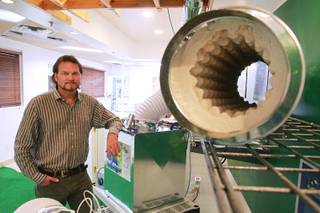Jon Harms describes himself as a “mad inventor.”
By day, he works as director of entertainment for the Forum Shops at Caesars Palace. At night, he toils away in a lab.
“I’ve always been interested in how to make something more efficient,” said Harms, who has multiple design and product patents.
Harms’ quest for efficiency led him to invent the AerMist system, an air conditioner supercharger. He envisions people using it in homes and businesses – anywhere air conditioning is needed. He says his system can save people up to 20 percent on heating and cooling costs and has the ability to be portable.
“It’s stunning,” Harms said of the cold-air system as he put a jacket on in his lab, a former deli between Rainbow Boulevard and Sahara Avenue. “I’m not saying it’s the next light bulb. I like to say, ‘I’m the first light bulb for improving ACs.’ That’s huge, because everyone has an AC in this town and in the southwest.”
The system isn’t available commercially yet, but Harms said he is close. The system is being prepped for mass marketing.
One product, the EcoDitioner, can boost the power of a quarter-ton air conditioner to the equivalent of a 2-ton unit. Running the EcoDitioner costs about 7 cents an hour, significantly less than a 2-ton unit, which costs 42 cents an hour. The system also uses less water than traditional evaporative coolers, known as swamp coolers.
“It’s a swamp cooler without the swamp,” Harms said. “It’s so hyperefficient. Every ounce of water is used to cool.”
Harms’ invention works by adding special ducts and ceramic rocks to traditional air conditioners. He invented both the cooling ducts and the rocks.
The rocks trap moisture and cool air from the air conditioner, so when it is shut off, a booster continues to push cold air stored in the rocks into the rooms. That keeps the area cooler for longer periods of time than a traditional air conditioner, which only cools when running. The system also requires less energy than its conventional counterparts because the compressor doesn’t have to fire as frequently.
“Your cycling time is longer,” said Harms, who added that the system works the same way for heating. “The biggest killer on the AC is the big old compressor.”
The cost of the system varies but starts at around $2,000. It can be installed in a single day.
Bart Pearson, a general contractor at Pearson and Pearson Construction in Las Vegas, plans to install the AerMist system in his home and sell the system in future contracts. He calculated his return on investment on the AerMist and found he will recoup his costs faster than with other green options, such as solar panels and generators, which can take decades to pay off.
“It’s a smart investment in Vegas,” Pearson said. “As I move people toward green, (the AerMist system) is another facet on how I can save them money, and it puts them on the green side rather than the wasteful side.”
This isn’t the first time Harms has come up with a solution to improve efficiency.
At the Forum Shops, he suggested switching from Halogen light bulbs to more cost-efficient LED lights. It saved an estimated $200,000.
Harms also is working on a dog cooling unit, called Kool-A-Pet, which uses a similar rock-cooling technology. It was Harms’ work on Kool-A-Pet 25 years ago that sparked the idea for the AerMist system (along with the quest to lower cooling and heating costs).
“A lot of people have a lot of good ideas, but a lot have a lot of bad ideas too,” Harms said. “Having a good concept and product is great, but you have to take the knowledge to create and ego and take a risk. There are so many things involved in making something simple.”

